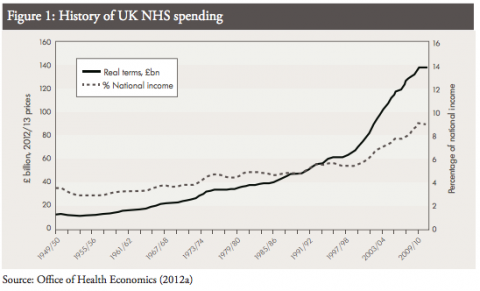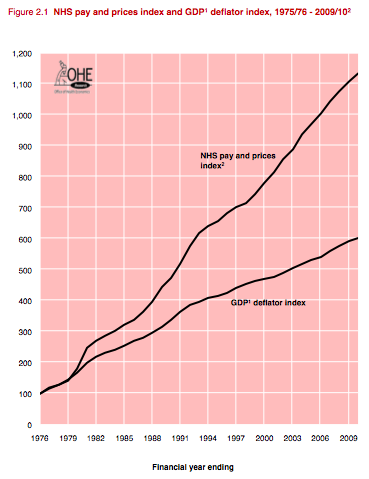Is NHS spending rising or falling?
A riddle
The Health Secretary, his Labour shadow and the Chair of the UK Statistics Authority walk into a pub. They start discussing the NHS budget.
After ordering a round of shandies, talk turns to the health service budget. Jeremy Hunt says, "real-terms spending on the NHS has increased across the country."
Then Andy Burnham protests: "he has cut the NHS budget for two years running and he owes it to patients and NHS staff to be honest about that. He can't manipulate the statistics and expect to get away with it."
Join 72,953 people who trust us to check the facts
Sign up to get weekly updates on politics, immigration, health and more.
Subscribe to weekly email newsletters from Full Fact for updates on politics, immigration, health and more. Our fact checks are free to read but not to produce, so you will also get occasional emails about fundraising and other ways you can help. You can unsubscribe at any time. For more information about how we use your data see our Privacy Policy.
The Labour MP then turns to Andrew Dilnot, the Chair of the UK Statistics Authority, and asks him to back him up.
At first Mr Dilnot appears to support Mr Burnham's take on the numbers: "Expenditure on the NHS in real terms was lower in 2011-12 than it was in 2009-10". But then he adds, "it might also be fair to say that real terms expenditure has changed little over this period."
As far as we know, this little assembly in the Red Lion never took place. However Mr Hunt and Mr Burnham have nevertheless been involved in a very public war of words over the NHS budget, and Mr Dilnot has found himself in the middle of it.
Some background
Late last year, Labour's Shadow Health Secretary wrote to Mr Dilnot to complain of "misleading claims on NHS spending by Government Ministers." Specifically, he took issue with the Coalition pledge that spending on health would rise in every year of this Parliament.
Mr Dilnot replied that the best available data suggested that in 2011-12 there was a slight dip in spending, but that the budget had remained largely flat in real terms since the Coalition took office.
Andy Burnham was adamant: Mr Dilnot's words confirmed his position. However Health Secretary Jeremy Hunt also claimed victory, telling the House of Commons during a debate on Mr Dilnot's letter that:
"the head of the UK Statistics Authority says that the broad picture of NHS spending is that it has been protected in real terms."
Anyone watching this exchange would have every reason to be puzzled. Just what has Andrew Dilnot said, and what has been happening to the sums of money made available to the health service?
How is NHS spending measured?
As Andrew Dilnot suggests in his letter to the Health Secretary, it's quite tricky to calculate whether there's been a rise or fall in NHS spending:
"We are aware that there are questions of definition here. The year on year changes in real terms have been small and the different sources, including the Department of Health Annual Report and Accounts and the public expenditure figures issued by the Treasury, are not exactly the same."
However the Statistics Authority itself does seem to have reached a view on how best to approach the problem:
"the most authoritative source of National Statistics on the subject would seem to be the Treasury publication Public Spending Statistics, and I note that these figures were used in a Department of Health Press Release in July 2012. The most recent update to those figures was published on 31 October but the July 2012 release gives a more detailed breakdown."
He continues:
"On the basis of these figures, we would conclude that expenditure on the NHS in real terms was lower than in 2011-12 than it was in 2009-10. Given the small size of the changes and the uncertainties associated with them, it might also be fair to say that real terms expenditure had changed little over this period."
In other words, Mr Dilnot is saying that the numbers are approximate enough to suggest there's either been a decrease in NHS spending or it has been effectively maintained. However, he appears to rule out the fact that there's been an increase.
Yet, in his reply to Mr Dilnot, Mr Hunt is delighted to suggest that this is what Mr Dilnot suggests:
"As your letter confirms, the most recent figures show that spending on the NHS increased in real terms between 2010-11 and 2011-12."
What do the numbers mean?
In order to understand the disagreement over the numbers, we need to put the figures in context.
The NHS budget might have increased nominally, but that doesn't mean that there's more money available in real terms. In order to calculate this real value, the government's statisticians apply a tool referred to as a GDP deflator (Mr Dilnot references this in his letter). This makes it possible to compare how spending varies between financial years by eliminating the distorting effect of inflation.
Here is the first set of estimates for NHS spending and how it has changed over the past 5 years:

We can see that this table (included in Mr Dilnot's letter) shows small consecutive decreases in real NHS expenditure for 2010-11 and 2011-12. However this isn't the only way of looking at the figures. Since the above table was published, the GDP deflators themselves have been revised, and if we apply the new deflators to the spending figures, the result is slightly different:
Now we appear to be dealing with a larger decrease in 2010-11 but a small increase in 2011-12. It is this 0.09% rise that Mr Hunt is interested in and to which he refers in his official response. He dismisses the -0.84% figure, arguing that the Coalition inherited the 2010-11 budget from the previous administration and therefore it had no say in determining it.
How useful are these numbers?
In political terms, the stakes are high. The Coalition Agreement of 2010 promised that:
"We will guarantee that health spending increases in real terms in each year of the Parliament."
Even if we allow for Jeremy Hunt's interpretation of the figures, this pledge isn't strictly being honoured: while the present Government might argue that it wasn't responsible for the NHS budget in the 2010/11 financial year, it does nevertheless fall within this Parliament.
But while the change might be significant to politicians, is it significant to the people who use NHS services?
A look at the history of NHS spending means that we're able to put the claims and counter-claims of the Health Secretary and his Labour Shadow in some kind of context. As the Institute for Fiscal Studies (IFS) observed, the scale of the change in NHS budget suggested by the Public Spending Statistics is minor in comparison to the size of the increases in health spending that have taken place in recent years.
Whereas Mr Hunt and Mr Burnham's disagreement hinges on an increase of 0.09% or a decrease of 0.02%, the average annual increase in the NHS budget under the previous Government was 6.4%. Historically speaking therefore, NHS spending remains at relatively high levels, regardless of who is correct. This is presumably the reason that Mr Dilnot concluded that "it might also be fair to say that real terms expenditure had changed little over this period."

What does this mean for services?
While the changes under the microscope might be relatively small, we shouldn't necessarily conclude that this debate is unimportant.
Crucially, the quality of service received by patients isn't necessarily determined by the amount of money put into the NHS.
For example, the 2011 Census found that the number of over 65s living in England and Wales grew by 10% in the last decade alone. As the House of Commons Library has reported, the Department for Health estimates that it costs nearly twice as much to treat someone over-65 as it does to provide services to those under retirement age. Some of the recent increase in spending might therefore have been driven by the increased demand that we associate with demographic change.
Similarly, the cost of providing health services hasn't necessarily kept pace with inflation. While the dispute between Jeremy Hunt and Andy Burnham centres on academic revisions to GDP deflators, these deflators themselves might not best represent the increases in the costs associated with providing healthcare.
In fact, the Office of Health Economics has found that these costs - such as paying doctors' wages and purchasing drugs - have consistently risen faster than the overall measure of inflation. The NHS might therefore require more than 'real terms' increases in funding just to maintain its present levels of service.

(This isn't to say that the GDP deflators aren't useful, as they can give us an insight into the relative importance being given to NHS spending with respect to the rest of the economy.)
Where do we go from here?
Nigel Lawson once described the NHS as "the closest thing the English have to a religion" and the main political parties are eager to be seen as keepers of the national faith. The dispute between Jeremy Hunt and Andy Burnham has, unsurprisingly, been played out in the media with both politicians selectively quoting statistics that support a particular narrative.
But the problem isn't limited to this single instance. NHS spending has been a huge issue of contention in this Parliament, and the debate has shown no sign of becoming clearer or more informative.
Therefore, up until the 2015 election, Full Fact will be compiling a variety of metrics in an attempt to understand how our health service is changing. We'll look at what's happening to the overall budget, to staff numbers and to waiting times.